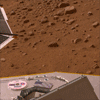|
2001-2006 |
2007 |
2008
|
| Date |
Title |
| 02-Sep-2008 |
How to Explore Mars: Get There Safely! |
 |
Like space shuttle pilots, Mars navigators need to know what the atmosphere will be like during landing. When Phoenix arrived, it barely missed a dust storm. Now scientists are evaluating what conditions may be like when the Mars Science Laboratory rover arrives in two years. That's one Mars year, or one change of seasons.
Read More...
|
|
| 28-Aug-2008 |
A Tribute to Mars Exploration |
 |
As Americans celebrate Labor Day 2008, six flags stand in silent salute to the U.S. workforce on Mars. Three of the flags are on spacecraft still exploring Mars. Those include NASA's twin rovers and the Phoenix lander. One of the flags, on Mars Pathfinder, landed July 4, 1997. Two, on the Viking spacecraft, arrived in 1976, the year of the U.S. bicentennial.
Read More...
|
|
| 14-Aug-2008 |
Seeing Through Hidden Layers of Mars |
 |
Mars' north polar cap swirls like a slowly melting ice-cream cake. Hidden within the layers is a record of the seasons, as polar ice disappears in summer and reappears in winter. The record is as old as the layers are deep, like the pages of a history book.
Read More...
|
|
| 28-Jul-2008 |
Rivers Ran Through It |
 |
Lakes and rivers with the potential to support life covered much of ancient Mars. Those areas where water deposited clay minerals would be good places to search for signs of past life.
Read More...
|
|
| 19-Jun-2008 |
The Perfect Weather Forecast |
 |
Let's say you live in Miami. If Earth's weather were as predictable as Mars' weather, you could expect a hurricane similar in magnitude to hit Miami year after year, within about two weeks of the same date.
Read More...
|
|
| 09-Jun-2008 |
Two Kinds of Ice |
 |
Mars has two kinds of ice in its polar caps, frozen water and frozen carbon dioxide (dry ice)! To humans, they look the same -- snowy and white -- but a NASA spacecraft "sees" the difference with a special detector.
Read More...
|
|
| 23-May-2008 |
Getting By with a Little Help from Friends |
 |
When NASA's Phoenix Mars Lander prepares for landing on May 25, 2008, it won't be alone. Three spacecraft in orbit will serve as a welcome committee.
Read More...
|
|
| 09-Apr-2008 |
Images of Phobos |
 |
The High Resolution Imaging Science Experiment (HiRISE) camera on NASA's Mars Reconnaissance Orbiter took these images of the larger of Mars' two moons, Phobos, on March 23, 2008.
Read More...
|
|
| 10-Mar-2008 |
The Incredible Mars Telescope |
 |
Imagine having a backyard telescope so powerful you could easily see details on another planet. NASA has such an instrument at Mars and recently pointed it at Earth!
Read More...
|
|